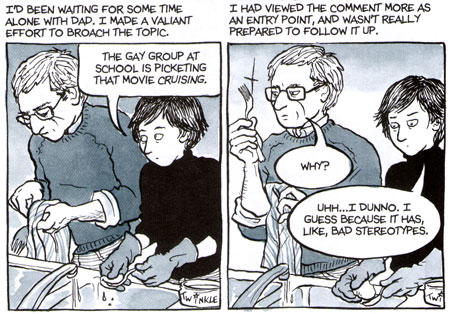A couple years ago
I had to write an analysis on Fun Home’s
first chapter, Old Father, Old Artificer,
which was provided by itself in a textbook. I remember being proud of the piece
I wrote (though it’s not as good as my current writing), so I was looking forward
to reading the whole novel and finally getting further into the context. This
is what I wrote for the first chapter a few years ago:
“The graphic
memoir, Alison Bechdel's Old Father, Old
Artificer, recalls Bechdel's father showing little emotion, with the
occasional burst of anger, keeping up the appearance of the family, and more
importantly, their house, by using his children to assist him in the process.
To him, making the house look pleasing to others was a cover for his secret -
his attraction to the high school students he taught. Within the memoir,
Bechdel compares her father to Daedalus, whose craft led to the death of his
son. At one point in the story, she writes herself starting to rebel against
her father and the way he sees things. The memoir's comic format shows how the
father was making the house almost like a labyrinth, and she wanted to get out.”
This is
still pretty accurate – Alison comes across things in her childhood, which she
analyzes in an effort to shape her identity. However, her father doesn’t want
her to end up like him, so he strives to keep her in the unassuming image he
has for his family. Even though Alison eventually leaves the house for college,
she is still caught up in trying to understand her father and trying to get on
his level, while at the same time discovering her sexuality, which she tries to
keep hidden from her family as well.



